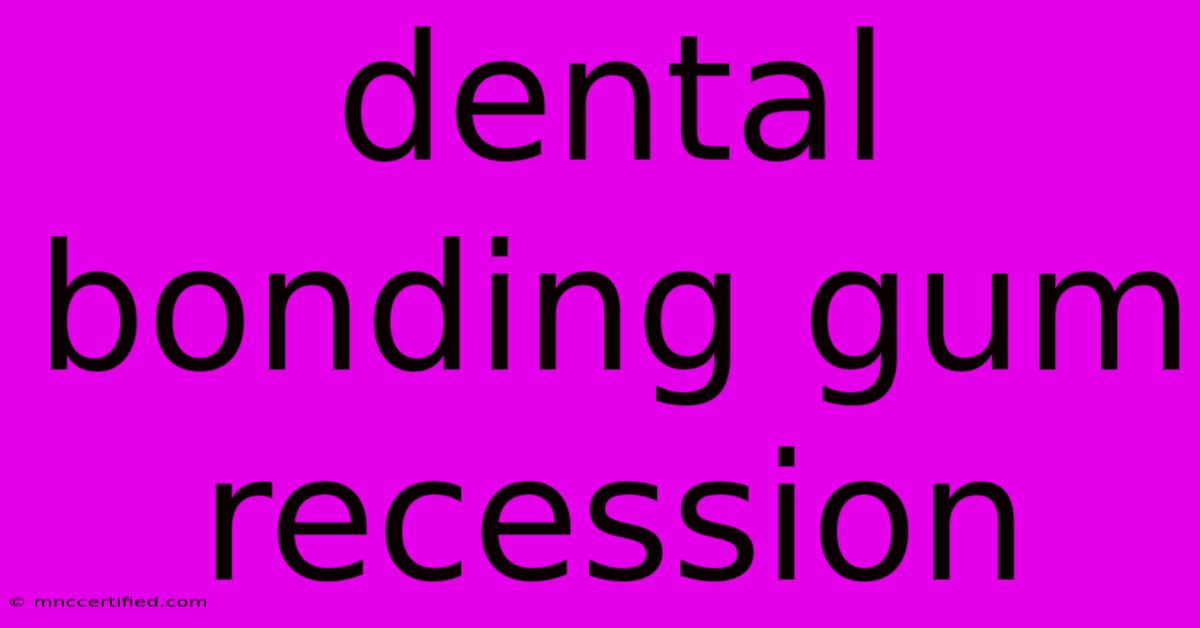Dental Bonding Gum Recession

Table of Contents
Dental Bonding for Gum Recession: A Comprehensive Guide
Gum recession, the process where your gums pull back and expose more of your teeth, is a common dental problem affecting millions. While it can be caused by various factors, including aggressive brushing, periodontal disease, and genetics, it can significantly impact your oral health and aesthetics. Fortunately, dental bonding offers a viable solution for treating mild to moderate gum recession, improving both the look and feel of your smile. This comprehensive guide delves into the details of using dental bonding to address gum recession.
Understanding Gum Recession and its Causes
Before exploring the solution, let's understand the problem. Gum recession exposes the roots of your teeth, making them sensitive to hot and cold temperatures, potentially leading to tooth decay and even tooth loss. Several factors contribute to gum recession:
- Aggressive Brushing: Brushing too hard or using a hard-bristled toothbrush can damage the gum line over time.
- Periodontal Disease (Gum Disease): Infections and inflammation associated with gum disease are major contributors to gum recession.
- Genetics: Some individuals are genetically predisposed to gum recession.
- Teeth Grinding (Bruxism): Grinding your teeth puts excessive pressure on the gums, contributing to recession.
- Misaligned Teeth: Crowded or misaligned teeth can put extra stress on the gums.
Dental Bonding: A Conservative Approach to Gum Recession
Dental bonding is a minimally invasive cosmetic procedure that involves applying a tooth-colored resin to the affected areas. This resin is carefully shaped and polished to blend seamlessly with your natural teeth, effectively masking the appearance of gum recession. It's a preferred treatment option for mild to moderate gum recession due to its:
- Conservatism: It's less invasive than other gum recession treatments, requiring no surgery or stitches.
- Speed and Efficiency: The procedure is typically completed in a single appointment.
- Affordability: Compared to other options, dental bonding is often a more cost-effective solution.
- Natural Appearance: The resin is carefully matched to the color of your teeth, resulting in a natural-looking restoration.
How Dental Bonding Addresses Gum Recession
The resin used in dental bonding is carefully applied to the exposed root surfaces of the teeth. This creates a smooth, uniform appearance that covers the exposed root and gives the illusion of a higher gum line. The procedure is meticulous, ensuring the resin seamlessly blends with the existing tooth structure and gum tissue.
Alternatives to Dental Bonding for Gum Recession
While dental bonding is an effective option for mild to moderate gum recession, it's not suitable for all cases. Other treatment options include:
- Gum Grafting: A surgical procedure that involves taking gum tissue from another area of the mouth and grafting it onto the receding gum line. This is more invasive but effective for significant gum recession.
- Pinhole Surgical Technique: A minimally invasive procedure that uses specialized instruments to reposition the gum tissue without incisions or stitches.
- Enamel Matrix Derivative (EMD) Gel: A gel that's applied to the gum line to stimulate gum regeneration.
Choosing the Right Treatment: Consulting Your Dentist
The best treatment for gum recession depends on the severity of the recession, your overall oral health, and your individual preferences. It's crucial to consult with your dentist to determine the most appropriate course of action. They will conduct a thorough examination, assess the extent of your gum recession, and discuss the available treatment options, including the pros and cons of each.
Maintaining Your Results After Dental Bonding
While dental bonding is durable, it requires proper care to maintain its longevity. Practicing good oral hygiene is paramount:
- Gentle Brushing: Use a soft-bristled toothbrush and brush gently.
- Regular Flossing: Floss daily to remove plaque and food particles from between your teeth.
- Regular Dental Checkups: Schedule regular checkups and cleanings with your dentist to monitor your oral health and identify any potential problems early.
- Avoid Staining Foods and Drinks: Limit consumption of coffee, tea, red wine, and other substances that can stain your teeth.
Dental bonding for gum recession offers a conservative and effective way to improve the appearance and health of your smile. However, it’s essential to consult with your dentist to determine if it’s the right treatment for you. Early intervention and proper maintenance are key to preserving your oral health and the longevity of your dental bonding. Remember to always prioritize regular dental check-ups for optimal oral health.

Thank you for visiting our website wich cover about Dental Bonding Gum Recession. We hope the information provided has been useful to you. Feel free to contact us if you have any questions or need further assistance. See you next time and dont miss to bookmark.
Featured Posts
-
24 Hour Bond Cartersville Ga
Nov 30, 2024
-
Stephen Mulherns Difficult Year Pizza Express To
Nov 30, 2024
-
Black Friday Sephora Bestsellers On Sale
Nov 30, 2024
-
Singer Swift At Chiefs Game
Nov 30, 2024
-
Nick Cannon Narcissistic Personality Disorder
Nov 30, 2024